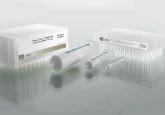First example of hepatocyte transplantation to alleviate ornithine transcarbamylase deficiency, monitored by NMR-based metabonomics

We demonstrate the effective use of NMR spectroscopic profiles of urine and plasma from the first successful use of hepatocyte transplantation as a bridge to auxiliary partial orthotopic liver transplantation in a child antenatally diagnosed with severe ornithine transcarbamylase deficiency. In this single-patient study, NMR profiles indicated that the disrupted urea cycle could be normalized by hepatocyte cell infusion and this was confirmed using orthogonal partial least-squares-based chemometrics. However, despite dietary manipulations and adminstration of ammonia scavengers, the desired reduction in plasma ammonia was not consistently achieved between sessions of hepatocyte transplantation due to episodes of sepsis. A subsequent liver...






